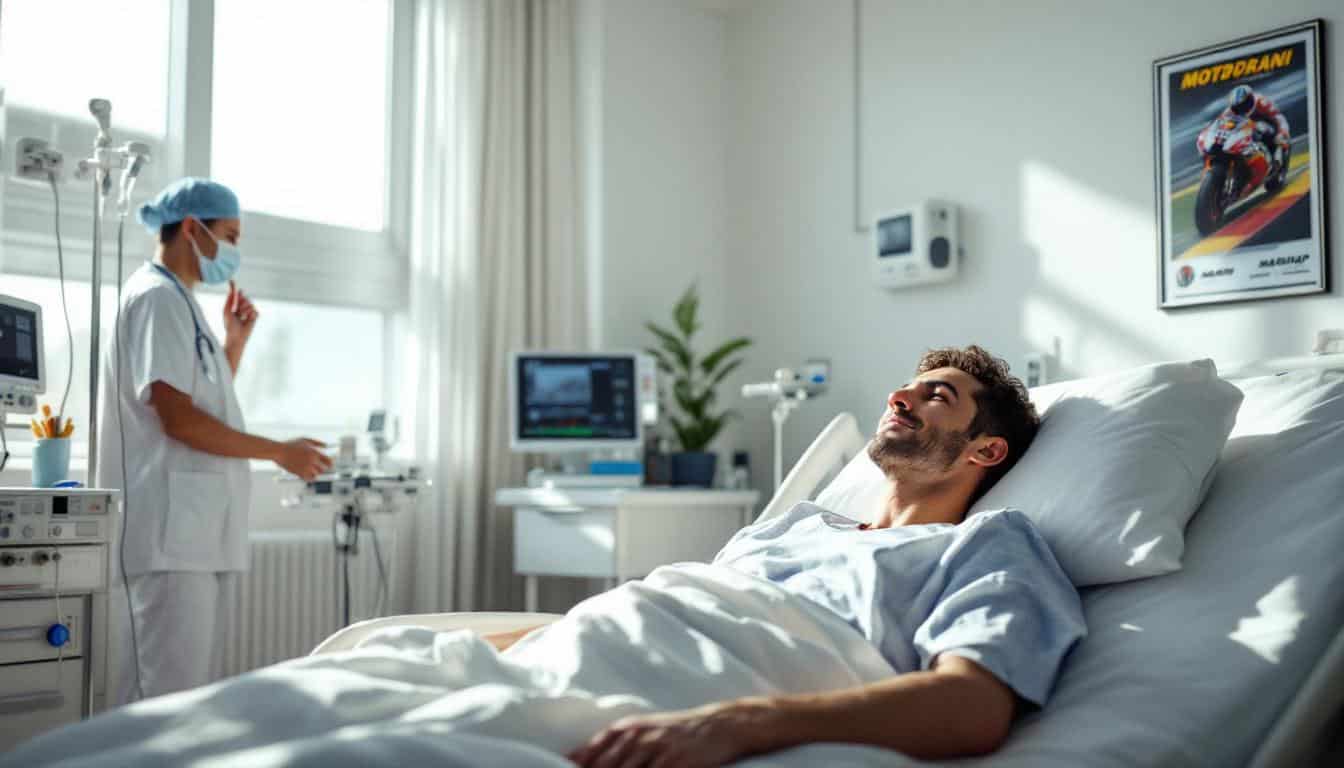The roar of engines, the thrill of speed, and the agony of injury are all part of the relentless world of motorsport.
This past weekend at the Dutch Grand Prix, these elements collided in dramatic fashion for the riders competing at Assen.
As racers push their limits, the stakes soar, and the aftermath can be uncertain.
Recent events have underscored the fragility of a racer’s body. Following a harrowing accident, Alex Marquez, a competitor riding for Gresini Ducati, has successfully undergone surgery to address a fractured left hand sustained during the race. The incident occurred on lap six, in a moment that saw him clash with Pedro Acosta’s KTM, leaving fans concerned for his future participation in upcoming races. As he sits second in the MotoGP championship, his team announced that updates on his recovery will be revealed soon, as speculation remains on whether he will be fit for the German Grand Prix on July 11-13.
In a more encouraging twist, Luca Marini is set to return to action with a two-day private test at Brno this week, just over a month after a serious crash in Suzuka. Although his injuries were serious enough to warrant hospitalization for ten days, his remarkable recovery has paved the way for his return to the track. Meanwhile, uncertainties linger regarding his teammate, Joan Mir, who faced a heavy crash during the Dutch Grand Prix, with doctors prescribing rest following a CT scan detailing no fractures but significant pain.
At the Brno test, factory rider Alex Rins and Pramac’s Miguel Oliveira will join the session representing Yamaha. The atmosphere is charged with anticipation, as the speed demons of the track prepare for their next challenges.

In the fast-paced environment of MotoGP, where every second counts and the stakes are high, recent developments regarding two key riders have captured the attention of fans and analysts alike. Alex Marquez has successfully undergone surgery following a dramatic incident during the recent Dutch Grand Prix at Assen, while Luca Marini gears up for his anticipated return after a challenging recovery journey. The nuances of these situations not only highlight the inherent risks of motorcycle racing but also underscore the resilience required from these athletes.
What happened to Alex Marquez during the Dutch Grand Prix?
During a pivotal race at the recent Dutch Grand Prix, Alex Marquez, who currently stands second in the MotoGP championship, experienced a catastrophic accident on lap six. As he collided with Pedro Acosta’s KTM, Marquez sustained a serious injury, fracturing his left hand. Such incidents are not uncommon in the high-octane world of MotoGP, where fractions of a second can mean the difference between victory and disaster. In this case, the fracture was classified as a subcapital fracture of the second metacarpal, a particularly nasty injury given the demands of manoeuvring a high-performance motorcycle.
In response to the injury, Marquez’s team, Gresini Ducati, promptly made public announcements regarding his condition. The surgery was completed successfully, addressing the fracture effectively. The timeline for recovery is critical, as MotoGP runs on a tight schedule. With the next race slated to occur in Germany from 11-13 July, fans and teams alike are awaiting news regarding whether he will be fit to compete. Gresini has reassured supporters that updates will follow soon. This incident serves as a stark reminder of the brutality of professional racing and the indefinite nature of athletes’ health post-injury.
How is Luca Marini preparing for his return to MotoGP?
Meanwhile, Luca Marini is preparing to make his comeback after a harrowing experience at Suzuka, where he sustained serious injuries in a high-speed crash. Emerging from his ordeal with remarkable determination, Marini is set to return to the track for a private test at Brno—just over a month after his accident. The seriousness of his situation cannot be understated; Marini was hospitalized in Japan for ten days due to a pneumothorax and multiple contusions that left fans worried about his future in the sport.
As he rejoins the competitive sphere of MotoGP, Marini’s return is pivotal not only for his career but also for the atmosphere within his team, Honda HRC. A month’s recuperation is a testament to modern medical and rehabilitative practices, which continue to advance in response to the physically demanding nature of motorcycle racing. Preparations for the private test include physical conditioning and mental readiness, both crucial for an athlete returning from injury. With the potential for future races inching closer, fans are eager to see how Marini handles the pressure and the need for recovery amid the rigors of MotoGP racing.
What are the implications for their teams and future races?
The events surrounding both Marquez and Marini carry significant implications for their respective teams. For the Gresini Ducati team, the absence of Marquez could impact their point standings in the championship, especially with the competitive landscape of MotoGP. Each race presents opportunities to gain valuable points, and missing even a single event can derail a team’s championship ambitions. The uncertainty regarding Marquez’s return adds pressure on team management as they must strategize for upcoming races, potentially relying on alternate riders to step in.
Conversely, Marini’s successful return could spark a surge of motivation within the Honda team after a period of hardship due to injuries. His teammate, Joan Mir, is also recovering from a serious crash at the same Dutch Grand Prix, which further complicates the dynamics within the team. The interplay of injuries has created a challenging environment, but it also fosters a sense of unity and resilience among the riders and staff alike.
The upcoming race in Germany not only puts the spotlight on Marquez and Marini but also unfolds as a narrative of resilience and determination in the face of adversity. Fans should anticipate thrilling performances as the athletes pool their experiences and training to conquer imminent challenges on the racetrack.
Recovery and Mental Resilience in MotoGP
Recovery from injury is not solely a physical journey; mental resilience plays a crucial role in an athlete’s readiness to return to high-stakes competition. Both Marquez and Marini exemplify this dual challenge as they navigate the complexities of healing. The psychological aspect often involves overcoming fear, adapting to new limitations, and reigniting the competitive spirit that defines MotoGP athletes.
Consequently, mental conditioning becomes part of their recovery protocols. Techniques such as visualization, mindfulness, or working with sports psychologists can help them regain their confidence and mental sharpness necessary for racing. The racing community recognizes that while the physical body can heal, the mind must also adapt and grow stronger post-injury.
In this context, the broader implications for MotoGP highlight the resilience required not only from the riders but also from their teams and fans who support them through thick and thin. As we look to the future of MotoGP, the stories of Alex Marquez and Luca Marini remind us of the courage and commitment that fuels this electrifying sport.
Keeping up with developments and fan engagement
As we closely follow the recovery trajectories of both Alex Marquez and Luca Marini, staying informed about the latest developments is essential for fans. The shared experiences of these riders often resonate on various platforms—be it through official team social media, podcasts, or dedicated motorsport news sites. Engaging with these updates allows fans to participate actively in the ongoing narratives that embody the motto of resilience.
For those eager to dive deeper into MotoGP topics, insights around accident recoveries prove compelling. Explore stories such as Carlos Sainz and Alex Albon’s challenges in the F1 sphere, offering parallels in resilience across racing disciplines.
For comprehensive updates on the MotoGP landscape, delve deeper into coverage including events like Lance Stroll’s comeback and comments from team management addressing contingencies related to rider health and performance at these competitive events.
With the summer racing calendar in full swing, the anticipation builds for both the thrilling races ahead and the stories of athletes who continually push the envelope of human performance.


